« August 2012 |
Main
| October 2012 »
 September 27, 2012 | Vamps Lessons on Mandolin Cafe
September 27, 2012 | Vamps Lessons on Mandolin Cafe
We're privileged to have our recent five-part chords series on Vamps including in the Mandolin Cafe resources pages. We'd featured two FFcP introductory lessons a number of years ago, so this has been a long time coming. If you haven't already, be sure to review them, not necessarily in sequence because we tried to write each lesson as a stand alone page. It's also important to internalize all the inversions, which isn't really that much with just three positions.
It's most effective to learn chords within a context of groups of chords. Fingers remember better when there's a sense of context, how each block differs from the next, which finger needs to move and/or resolve to the next. It's also important to learn good principles of smooth voice leading, and these popular groups of chords have been intentionally design with minimal movement.
Something we hope you will discover if you haven't already, a chord progression doesn't have to be sophisticated to sound sophisticated.
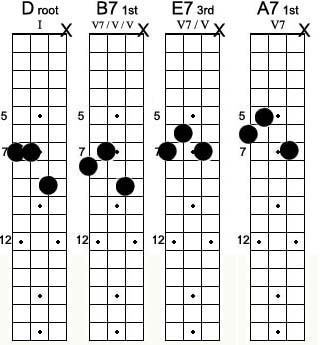
Once you're comfortable with the lessons--triads, passing chords, V7 leading and minor mode variations, take them to the next level by spreading the to other keys. You can run the Circle of Fifths or other transposition tricks, or even better, take songs you are working on and use these around the tonal centers expressed in these songs. In other words, "Autumn Leaves" which floats around E minor and G major would give you the opportunity to work out the vamps in those two keys before you start jamming to them. "There Will Be Another You" would use a lot of Eb and Ab major, so why not precede working on the song working on Vamps based around those keys?
We've given you the tools.
Now go build something fun.
View links: Vamps Lessons on Mandolin Cafe
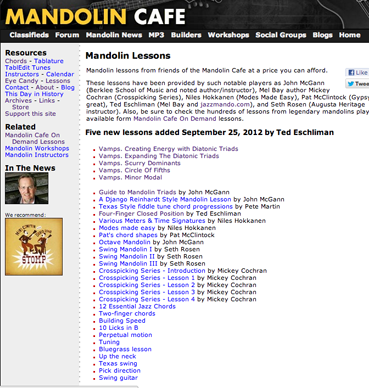
Posted by Ted at 11:24 AM
 September 20, 2012 | Vamps. Minor modal
September 20, 2012 | Vamps. Minor modal
On the last of our five part series on 3-note chord vamps, we'll look at how these might work in the minor mode. Recall we started simply, major triads. From these vanilla chords, we embellished, added some V7 propulsion, and navigated the Circle of Fifths somewhat in last week's Secondary Dominants. If you haven't noticed, each week we offered three different positions (inversions) which gives you virtually unlimited opportunity to transpose up and down the fretboard and across strings. We can't stress enough how much this opens up your chord accompanying, let alone develops a foundation for more advanced chords and chord melody composition.
It's time to throw in the minor mode. Recall the first lesson of major triads where we walked up the neck based on the first four notes of the scale:
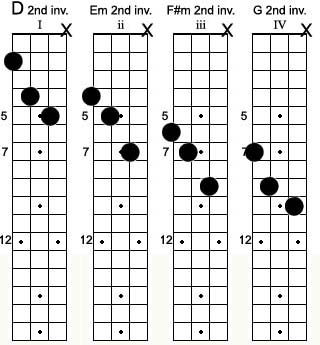
We'll do a minor version of this, now:
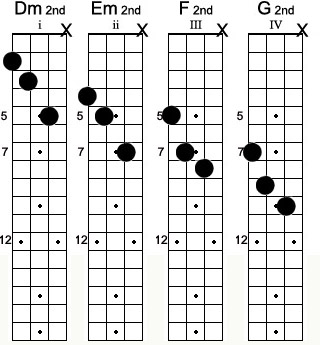
Of course, you can just take the first three chords and jam to Van Morison's "Moondance," Michael Jackson's "Billie Jean" or any number of minorish mode pop tunes.
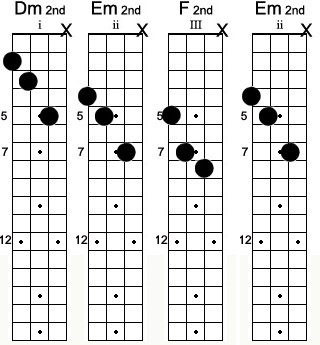
The theory purist will be exorcised all over this, noticing the ii chord is not of the minor mode. We're probably more accurate calling this first block "Modal" or "Dorian" since the ii chord of a minor scale has a b5 (diminished), and we'll deal with this when we want to express more harmonic accuracy. Remember, the context here is just vamping.
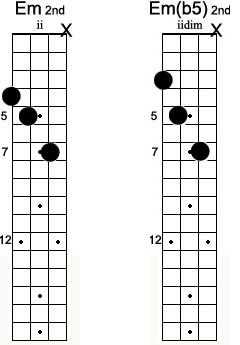
Indeed, Eb(b5) is more accurate, and if we use this as chord to set up the dominant (V7), you'll probably choose this instead. Here you go, a "ii7b5 V7" mini progression:
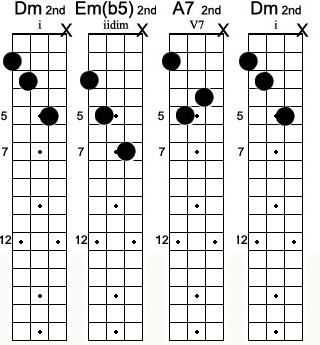
Read to move this up the neck? Of course you are. Here is the next inversion:
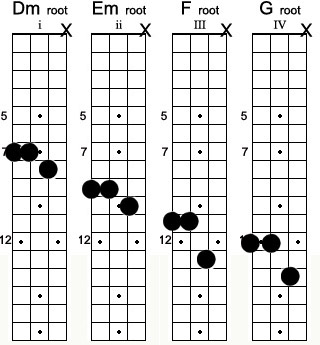
And its "ii7b5 V7" mini progression:
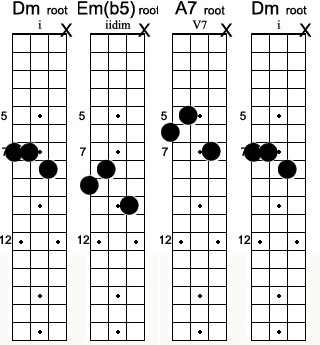
The final inversions:
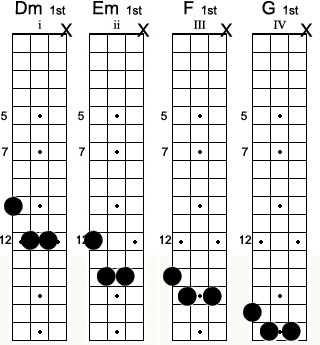

This last set is pretty far up the neck, and hopefully this pushes you to experiment with more accessible transpositions of the blocks. Try doing the preceding Dm grips down five frets as Gm. (And of course, all 12 keys!) You're thinking chord patterns, rather than individual chords, and in a highly usable context.
Enjoy the rich resources of 3-note Vamps!
Further
Vamps Pt 1. Creating energy with Diatonic triads
Vamps Pt 2. Expanding the Diatonic triads
Vamps Pt 3. Scurry Dominants
Vamps Pt 4. Circle of fifths
Making the most of Minor Keys
Posted by Ted at 10:26 AM
 September 13, 2012 | Vamps. Circle of fifths
September 13, 2012 | Vamps. Circle of fifths
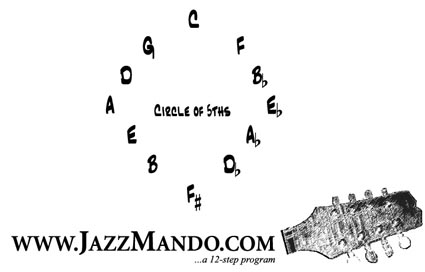
We're now on our fourth of a five-part series on 3-note vamping chords. We started simple with triads, moved to embellishing/passing chords, and dipped our toes into dominants last week, but this time we want to exploit a common music theory concept discussed many times before, the circle of 5ths. As we uncovered last week, you can do a lot to propel the harmonic progression of any song with a V7 chord, even add some that weren't there in the first place. We did this with a simple diatonic progression:

Note we took the ii chord of D (Em) and inserted its dominant, the B7. This time we want to take the V7 of the V chord, E7 and replace the Em:
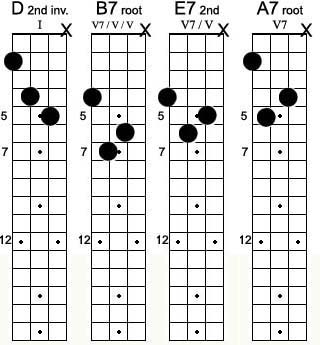
Subtle point: In shorthand, many will refer to this as a major II (II7) chord, but that's technically incorrect, as the two chord of the major scale is not major. As we've demonstrated in this series, we want to think functionally, not just what the chord is, but what it's doing. In this case, it is modifying the A7 chord (V7), so the reason we call it the V7 of V (V7 / V) is to imply purpose. It may seem a long way to go around it, but ultimately, the goal is to give you a harmonic tool you can repeat and use in other keys!
Continue with the other inversions up the neck:

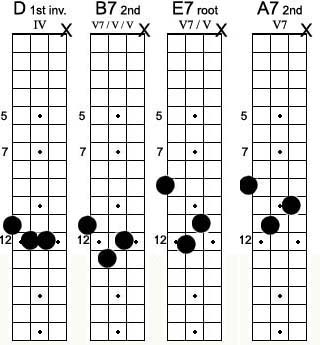
Now, even though we are in the key of D, let's take this one step further and demonstrate what is commonly called a Turnaround. We're going to take the V7 of the V of V (F#7). A lot of jazz is thinking backwards. Take your destination home key (D) V7 (A7). A step before that is the V7 of V (E7) we've already blocked. Now rather than use the tonic key D, let's inject the V7 of the V of V (V7 / V / V), F#7.
VII7 or V7/V/V ?
Again, some might call the F#7 the VI7, in the key of D, but we still want to imply function. We're on a "secondary" Dominant Journey, and as we mentioned earlier, we're traveling the Circle of 5ths:
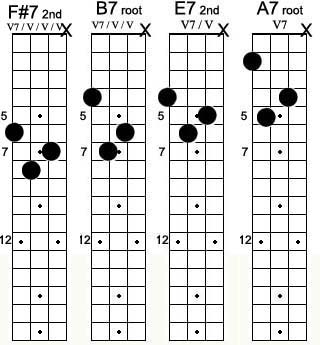
Note, even though there is no D chord in this block you are still implying "D-ness" by ending it on the A7, the V7 chord. A D major will follow it all nicely!
Blocking out the other inversions for you:
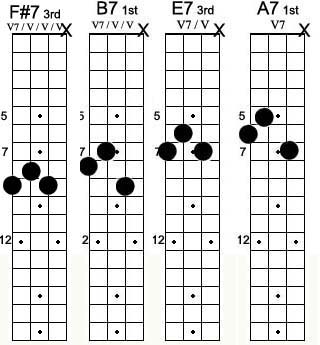
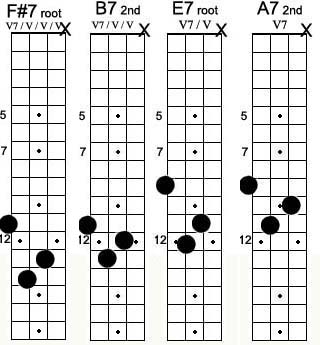
Notice how smooth the voicing is on these, minimal movement fret to fret. Even if you didn't intellectually grasp the "science" in all this, you have to admit it's a pretty cool sound.
Further
Vamps. Creating energy with Diatonic triads
Vamps. Expanding the Diatonic triads
Vamps. Scurry Dominants
Secondary Dominants
Functional thinking...
Posted by Ted at 11:20 AM
 September 6, 2012 | Vamps. Scurry Dominants
September 6, 2012 | Vamps. Scurry Dominants
We've had some fun with simple 3-note chord blocks based on triads in our last two articles on Vamps. The concept is taking simple static chord measures and energizing them with some chord motion, and not disrupting the harmonic integrity of the music. Using "diatonic" chords, those based on the scale of the key, we've done this with the I, ii, iii, and IV triad chords, and last week, some extra "approach" chords.
This time we want to go another step beyond and add the V7 chord. One might think the I and the V7 would clash, but actually, when it's used briefly it becomes more of an instant departure. The V7 really wants to push back to the I, and you set up a mini progression within a progression. Take a look at the following block:
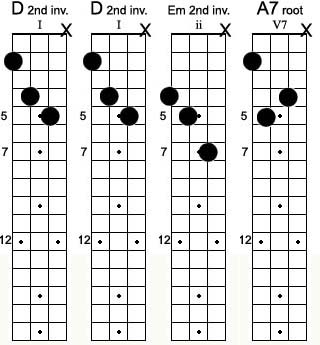
All we are doing is adding a 'ii V7' to the I. Repeat these over and over, you get the "Vamp" effect we've been studying. It's far more interesting than the I, I, I, I voice (yawn...) you might do if all the music called for was a D chord.
Take a look at other fretboard incarnations of the V7 chord:
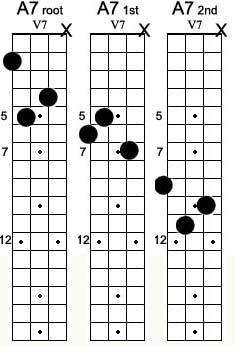
We can inject these into other voicings of the 'I ii V7' in D:
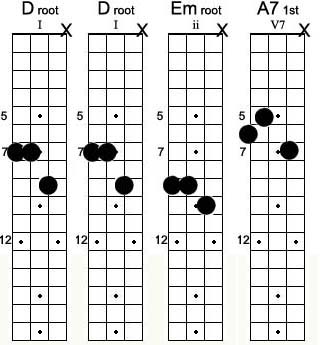

Again, you can transpose these blocks all over the fretboard in other keys. Try moving everything up a fret. Makes playing in the key of Eb a snap!
Remember, we're sneaking the V7 where it wasn't before. Playing it fast, a sort of "scurry" dominant, you can inject the V7 chord just about anywhere in a song. Get in--get out. We going to take the trick one step farther and add the V7 of the ii chord, the B7, injecting the B7 blocks.
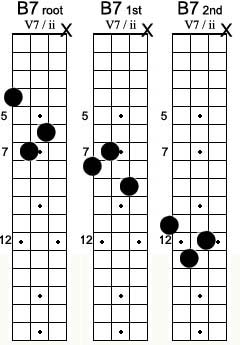
We'll add this to the progression, and note if you scurry this, it still balances spice with the integrity of the home key.

Add this to the other inversions:
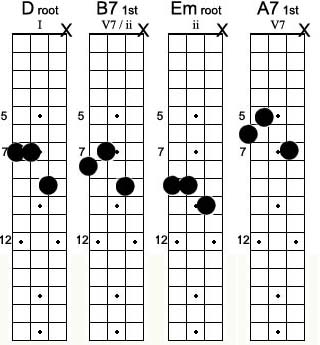
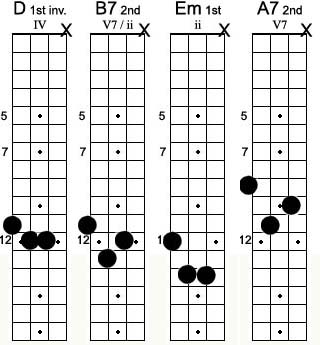
We mentioned moving it up a fret to apply in the key of Eb. Now you can go all over the place with these. Does the progression sound familiar? (Check out the chords for "I've Got Rhythm.") You'll find this all over the place, and don't limit yourself to places where it's written out.
Season to taste.
Further
Vamps. Creating energy with Diatonic triads
Vamps. Expanding the Diatonic triads
Secondary Dominants
Static Changes: V7 chords
Understanding the 'ii V7 I' Progression
Posted by Ted at 6:17 AM

Disclaimer: In the 'Information Age' of the 21st Century,
any fool with a computer, a modem, and an idea can
become a self-professed 'expert." This site does not
come equipped with 'discernment.'
|



